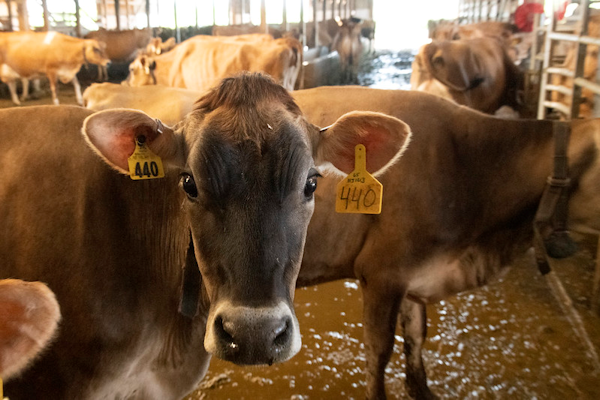SEJournal Online is the digital news magazine of the Society of Environmental Journalists. Learn more about SEJournal Online, including submission, subscription and advertising information.
 |
| Reporting on air and water pollution from concentrated animal feeding operations is made more difficult by the lack of data. Above, cows at a dairy in Washington State. Photo: USDA/Lance Cheung, public domain image. |
Reporter’s Toolbox: CAFO SNAFU — Why Emissions Data Are So Hard To Find
By Joseph A. Davis
You may have a hefty toolbox in your garage — yet can’t find the darn wrench. Well, this is that Toolbox. As we’ll explain, finding data on air and water pollution from concentrated animal feeding operations, or CAFOs, is close to impossible.
As a journalist, you should know that that is not an accident. Farm lobbyists have seen to it. More than two decades after the U.S. Environmental Protection Agency started trying to confront pollution from CAFOs, the information (and regulations) are still murky.
It would not be accurate to say that the ag industry has gotten the most exemptions from environmental protection laws. That honor belongs to the oil and gas industry. But since major environmental laws were passed in the 1970s, the EPA has learned the political difficulty of regulating agriculture directly. So have the green members of Congress.
That’s because the structure of the U.S. federal system gives farm states a voting advantage. As a result, many of the environmental problems created by ag are addressed with money (or “incentives”) rather than coercion.
Air and water CAFO emissions
have harmful health and environmental
impacts and are an environmental
justice issue in many places.
Why bother? Well, both air and water CAFO emissions have harmful health and environmental impacts. And these affect vulnerable populations disproportionately, making it an environmental justice issue in many places.
If you ever get close enough to a large cattle or pig operation, the smell alone will convince you. Imagine working there. Now imagine living nearby all the time.
Estimating emissions … or not
We were reminded of this data deficit reality by a recent piece in Investigate Midwest by Madison McVan. The headline: “18 years and counting: EPA still has no method for measuring CAFO air pollution.” That’s how long (at least) the EPA and others have been trying to produce a way of producing data.
The EPA effort is called the National Air Emissions Monitoring Study, or NAEMS. It is meant to create tools good enough to estimate a particular CAFO’s air emissions.
Of course, you can’t attach a meter to a cow or pig, so the goal is to come up with emissions estimating methodologies, or EEMs, which could do a scientifically credible job of quantifying a particular operation’s emissions. Without EEMs, the agency can’t regulate, really.
But it’s way more complicated than that, as befits a two-decade chronicle of political and legal conflict (actually, two different sagas, one for air emissions and another for water emissions).
The political winds have shifted from administration to administration. The SEJournal has written about this before, when the EPA withdrew its CAFO database rule in 2012. The Trump administration simply rolled back much of the effort. Now the Biden EPA may be trying to get it back on track. We will see.
Suggestions for digging up data
What is an environmental data journalist to do? We have a few broad suggestions.
- Look for state-level data: Since the EPA and Congress have left much authority to states, check whether your state has any databases that can help your reporting. A few states do. Start by looking at Michigan, Wisconsin, Oregon, Iowa, Colorado or Missouri.
- Talk to local groups: If CAFOs are a big thing in your state, it is likely that some statewide or local green groups are making a fuss. Find them. Talk to them.
- Seek out your state ag colleges: Despite a possible bias, they may be researching CAFOs and may need data to do that. Researchers love data. You can start with this list from the Ag Department.
- Use water permits: Because larger CAFOs in some areas are required to have national pollutant discharge elimination system permits, state and federal databases may allow you to do some crude tracking of operations.
- Use Ag Department data: Ever looked at the Census of Agriculture? The Ag Department produces it every five years or so. The next one will be dated 2022, but it isn’t actually out yet. The good thing is that it catalogs almost every farm of any importance, and breaks data down to county level or below.
- Watch the Farm Bill: Congress is very likely to produce a Farm Bill in 2023 (or soon after), and this sprawling bill can touch anything ag-related. We do not know that Congress will do anything about CAFO data in this bill — it could as easily block it as promote it. SEJournal has a recent Issue Backgrounder on the bill.
[Editor’s Note: For further background, check out past SEJournal articles on CAFO data, including a TipSheet on flood-induced animal waste spills, plus visit our Topics on the Beat pages on agriculture and the food system.]
Joseph A. Davis is a freelance writer/editor in Washington, D.C. who has been writing about the environment since 1976. He writes SEJournal Online's TipSheet, Reporter's Toolbox and Issue Backgrounder, and curates SEJ's weekday news headlines service EJToday and @EJTodayNews. Davis also directs SEJ's Freedom of Information Project and writes the WatchDog opinion column.
* From the weekly news magazine SEJournal Online, Vol. 8, No. 21. Content from each new issue of SEJournal Online is available to the public via the SEJournal Online main page. Subscribe to the e-newsletter here. And see past issues of the SEJournal archived here.













 Advertisement
Advertisement 



